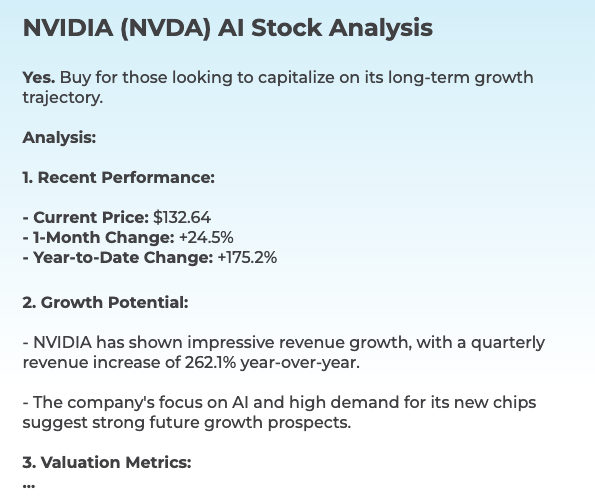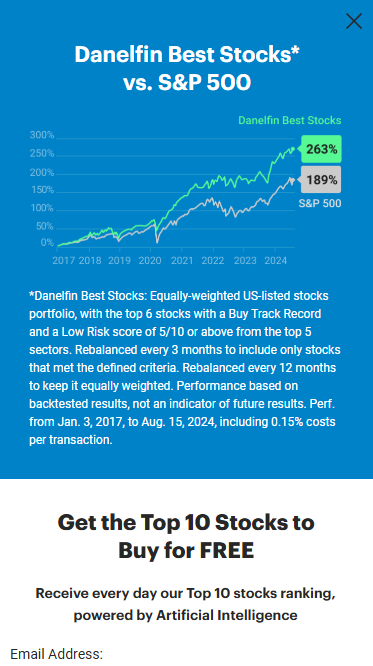20 Free Ways For Choosing AI Stock Prediction Websites
20 Free Ways For Choosing AI Stock Prediction Websites
Blog Article
Top 10 Tips To Evaluate The Strategy Customization Of AI stock Trading Platforms
AI software for predicting or analyzing stocks offers various options for customization that let users modify their platform to meet their individual trading goals in terms of risk-taking, as well as market condition. A platform that offers a wide range of customization options can boost the performance of your trading. Here are the top ten tips for evaluating the ability to customize your strategy on these platforms:
1. Evaluate Pre-Built Strategy Templates
Variety of templates: Determine whether the platform has various pre-built trading strategies (e.g. day trading, swing investing, long-term investments).
Easy of use: Evaluate how easily you can modify and adapt these templates to your needs.
Performance history: Determine if the platform provides historical performance data for previously-built strategies.
2. Review the Custom Strategy Development
Drag-and-drop tools: Find platforms that provide intuitive drag-and-drop interfaces to create customized strategies.
Coding options: Check if the platform supports custom-made coding (e.g., Python, R or any other scripting languages) for advanced users.
Flexibility: Ensure that the platform lets you define your entry and exit parameters as well as risk management metrics and other important components of your strategy.
3. Check for Backtesting Capabilities
Historical data: Check whether your platform provides enough historical data for testing strategies for backtesting.
Customizable parameters - Ensure that you can change parameters (e.g. indicators, timeframes) during testing backtests.
Performance metrics - Make sure to see if the platform provides detailed performance indicators (e.g. the win rate, Sharpe coefficient, or drawdown) for all strategies tested back.
4. Evaluate Real-Time Strategy Testing
Paper trading: Make sure the platform provides models for paper trading or simulation to test strategies in real-time without taking risks with capital.
Live testing: See whether you are able to run strategies live in markets using small amounts of capital to evaluate their performance.
Real-time adjustment: Determine whether it is feasible to adjust strategies according to the current market conditions.
5. Assess integration with technical indicators
Indicator Library: Determine if the platform has a library of technical indicator (e.g. moving averages, RSI or MACD).
Custom indicators - Make sure you are able to build or import your own custom indicators.
Examine the combinations of indicators.
6. Check for Risk Management Tools
Stop-loss/take-profit: Ensure the platform allows you to set stop-loss and take-profit levels within your strategies.
Size of the position: See whether you are able to define guidelines for the size of your portfolio (e.g. Fixed amount or percentage of your portfolio) to control risk.
Rate of risk-reward: Check if the platform allows for setting specific risk-reward rates for strategies or for individual trades.
7. Evaluate Multi-Asset Strategy Support
Asset classes: Make sure the platform supports multiple asset classes, such as stocks, ETFs and options.
Cross-assets strategies: Find out if you're able to design strategies that incorporate various asset classes.
Market coverage. Check if the platform covers the markets that you're interested in (e.g. US international, cryptocurrencies).
8. Assess Automation and Execution
Automated trading: Ensure the platform can automate execution of strategies using predefined rules.
Types of orders: Check to see if the system permits different order types (e.g. limit, market) when executing a strategy.
Latency: Check whether the platform is able to execute trades with minimal latency particularly when using high-frequency strategies.
9. Look for tools for optimizing your strategy.
Optimization of parameters: Ensure that the platform has tools to optimize the parameters of your strategy (e.g. grid search and genetic algorithm).
Machine learning integration Check to see whether your platform supports machine learning in order to improve and refine strategies.
Scenario analysis: Verify that the platform can test strategies under different market conditions (e.g. volatile bull, volatile, bull or bear).
Review User Support for Community Reviews and Feedback
The feedback of users is crucial in determining the effectiveness of a platform.
Community forums. Check if users are able to share information and discuss their ideas within a lively and vibrant community.
Support resources for users - Make sure that the platform provides guides and instructions for users to develop and optimize strategies.
Bonus Tips:
Trial period for free: You can explore the options for customization of the platform using a a demo or free trial.
Scalability - Make sure that the platform you choose is able to handle your evolving trading strategies.
Support for customers: Find out whether the platform is able to provide assistance with strategy-related issues or concerns.
These suggestions will allow you to assess the options for customization of AI trading platforms that can predict or analyze stocks. In this way you'll be able select one that is compatible with your goals in trading, and allows you refine and apply your strategies. Platforms that are flexible in their customization capabilities can assist you in adapting to the changing market conditions and improve your trading performance. Have a look at the top stock ai blog for site recommendations including investing ai, options ai, trading with ai, ai trading, AI stocks, ai trade, ai investing, market ai, AI stock trading bot free, trading with ai and more.
Top 10 Tips To Assess The Transparency Of AI stock Trading Platforms
Transparency is an important factor when evaluating AI-driven stock prediction and trading platforms. It ensures that users can trust the operations of the platform, understand how decisions are made, and validate the accuracy of the predictions. Here are the top 10 suggestions to assess the transparency of such platforms:
1. Clear Explanation of AI Models
Tip - Check that the platform provides a thorough description of the AI algorithms used to predict the future.
What's the reason? By understanding the technology, users are able to determine its reliability and limitations.
2. Disclosure of Data Sources
TIP: Determine if the platform makes public the data sources it uses (e.g. historical stock information, news, social media).
What do you know: By understanding the data sources will help you ensure that the platform uses reliable and comprehensive information.
3. Backtesting and Performance Metrics
Tip - Look for transparent reports on performance metrics such as accuracy rate, ROI and backtesting.
This will give users to evaluate past performance against the latest platform.
4. Updates in Real Time and Notifications
Tips: Check whether the platform is able to provide real-time updates and notifications about the predictions, trades or system updates.
Reason: Real-time transparency allows users to be informed of every critical action.
5. Limitations - Communication that is open
TIP: Make sure that the platform outlines its risks and limitations regarding forecasts and trading strategies.
Why: Acknowledging limitations builds trust and allows users to make educated decisions.
6. Data in Raw Data to Users
Tip: Evaluate whether users can access raw data, or even intermediate results utilized by the AI models.
The reason: Raw data access allows users to conduct their own analyses and test the results of their own predictions.
7. Transparency and openness in fees and costs
Check that the platform clearly lists the subscription fees as well as hidden charges.
Transparent Pricing: It creates trust by preventing costs that are unexpected.
8. Reporting on a regular basis and audits
TIP: Find out if the platform is regularly updated with reports or is subject to audits by a third party to confirm its performance and operations.
Why independent verification is important: It increases the credibility of your business and increases accountability.
9. Explainability in Predictions
Tips: Find out about the process by which the platform creates specific predictions or suggestions (e.g. the importance of features and decision trees).
Why is this? Explainability allows users to gain insight into the rationale behind AI-driven actions.
10. Customer Feedback Channels, Support and User Feedback
Tips. Find out if there are channels available to provide feedback from users, support, and transparency in responding to concerns of users.
What is the reason: Being responsive in communicating is a mark of dedication to openness.
Bonus Tip - Regulatory Compliance
Make sure the platform is compliant with all financial requirements. It should also disclose the status of its compliance. This adds an additional layer of confidence to the platform.
By thoroughly assessing these aspects you will be able to judge whether an AI stock prediction and trading platform operates in a transparent manner, allowing you to make informed choices and build confidence in its capabilities. View the most popular AI stock predictions advice for website tips including best stock prediction website, AI stock price prediction, stock trading ai, stock trading ai, free ai tool for stock market india, investing with ai, AI stock analysis, ai options trading, ai tools for trading, ai trading tool and more.